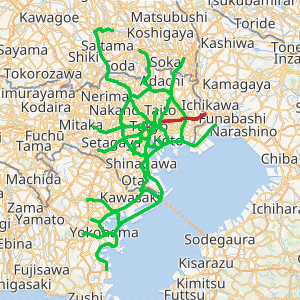Komatsugawa Route
The Komatsugawa Route (小松川線, Komatsugawa-sen), signed as Route 7, is one of the tolled routes of the Shuto Expressway system serving the Greater Tokyo Area. The route is a 10.4-kilometer (6.5 mi) long radial highway running east from the Tokyo ward of Sumida to the ward of Edogawa. It connects Tokyo's Mukojima Route in central Tokyo to the Keiyō Road which connects Tokyo to Chiba Prefecture and its capital, the city of Chiba.
首都高速7号小松川線 | |
|---|---|

| |
| Route information | |
| Maintained by Metropolitan Expressway Company Limited | |
| Length | 10.4 km (6.5 mi) |
| Existed | 1971–present |
| Major junctions | |
| West end | Ryōgoku Junction in Sumida |
| East end | |
| Highway system | |
| National highways of Japan Expressways of Japan | |
Route description

The Komatsugawa Route begins at Ryōgoku Junction with the Mukojima Route in Sumida ward above the Sumida River. From there it travels east through Sumida and Kōtō parallel to National Route 14 and the Sōbu Line before crossing over the Arakawa River in Edogawa. At this crossing the Komatsugawa Route passes beneath the Central Circular Route. The expressway has two junctions with local roads east of the crossing in Edogawa. After those junctions the expressway leaves the Shuto Expressway network, from there it continues east towards Chiba as the Keiyō Road.[1]
The speed limit on the Komatsugawa Route is set at 60 km/h.[2]
History
The entirety of the Komatsugawa Route was opened to traffic on 21 March 1971. The expressway was extensively rehabilitated in November 1991 under the project name "Route 7 Refresh Plan".[3] On 16 February 2015, the expressway was temporarily closed in Edogawa due to a fire that broke out during construction work on the route. The incident claimed the lives of two workers.[4]
In preparation for increased congestion during the 2020 Summer Olympics, new traffic-control systems were installed along many expressways in the Tokyo area. The only instance of further controls being installed along the expressway was at its western terminus at Ryōgoku Junction[5]
An additional interchange between the Central Circular Route and the Komatsugawa Route was opened on 1 December 2019. Part of the project to add the junction included upgrades to the already extant interchange at Komatsugawa.[6]
Junction list
| Location | km | mi | Exit | Name | Destinations | Notes | |
|---|---|---|---|---|---|---|---|
| Sumida | 0.0 | 0.0 | — | Ryōgoku | Western terminus; eastbound entrance, westbound exit | ||
| 2.0 | 1.2 | Kinshichō Toll Booth | |||||
| 2.3– 2.8 | 1.4– 1.7 | 701/702 | Kinshichō | ||||
| Edogawa | 6.6 | 4.1 | — | Komatsugawa | Eastbound entrance, westbound exit | ||
| 7.0 | 4.3 | 703 | Komatsugawa | Tokyo Metropolitan Route 308 (Funabori-kaidō) – Shinkoiwa, Funabori | Eastbound exit, westbound entrance | ||
| 8.4 | 5.2 | 705 | Ichinoe | Tokyo Metropolitan Route 318 (Kannana-dōri) – Haruechō | Eastbound exit, westbound entrance | ||
| 10.4 | 6.5 | — | Eastern terminus, expressway continues as the Keiyō Road | ||||
1.000 mi = 1.609 km; 1.000 km = 0.621 mi
| |||||||
See also


References
- "路線から出入口を探す" (in Japanese). Metropolitan Expressway Company Limited. Retrieved 12 November 2019.
- "Tokyo Shutoko Expressway: Japan's Busiest Road Network". Retrieved 12 November 2019.
- "首都高の歴史". Metropolitan Expressway (in Japanese). Retrieved 5 November 2019.
- "首都高の高架下で火災、作業員2人死亡 小松川線". Asahi Shimbun (in Japanese). 16 February 2015. Retrieved 12 November 2019.
- "首都高など交通規制スタート。東京オリンピック・パラリンピックを想定した混雑対策、7月24日/26日試行" (in Japanese). 24 July 2019. Retrieved 5 November 2019.
- "プレスリリース(2019年度)" (in Japanese). 18 October 2019. Retrieved 3 December 2019.
External links

